You’ll transform your Maryland garden from ordinary to extraordinary when you choose plants that actually belong here. Native species like Black-Eyed Susan and Purple Coneflower don’t just survive—they thrive in our clay-heavy soils and unpredictable weather patterns. These aren’t your typical garden center picks, but they’ll outperform those imported varieties every single time. The secret lies in understanding which natives work best in your specific conditions, and there’s more to this selection process than most gardeners realize.
Contents
Maryland’s Unique Soil Conditions
Maryland’s soil tells three distinct stories, each shaped by millions of years of geological history, climate patterns, and topography. You’ll find sandy coastal plain soils that drain quickly, clay-rich Hagerstown soils that hold soil moisture longer, and well-balanced Sassafras soils—the state’s official soil—offering ideal drainage characteristics across central regions.
Understanding these differences guides your planting strategies. Sandy soils require drought-tolerant natives with deep roots, while clay areas support moisture-loving species. Sassafras soils provide excellent soil fertility and support diverse native adaptations, making them perfect for maintaining ecological balance in your garden. These varied soil compositions also directly influence water runoff patterns, affecting how stormwater moves through your landscape and ultimately impacts the health of nearby waterways.
Stunning Wildflowers for Maryland
Maryland’s native wildflowers offer year-round garden interest with vibrant reds and pinks, spring ephemerals, summer bloomers, fall displays, and ornamental grasses creating diverse landscapes. These native species are particularly valuable for wetland restoration projects, with plants like Rosemallow thriving in brackish and freshwater marshes throughout the state.
Black-Eyed Susan (Rudbeckia)
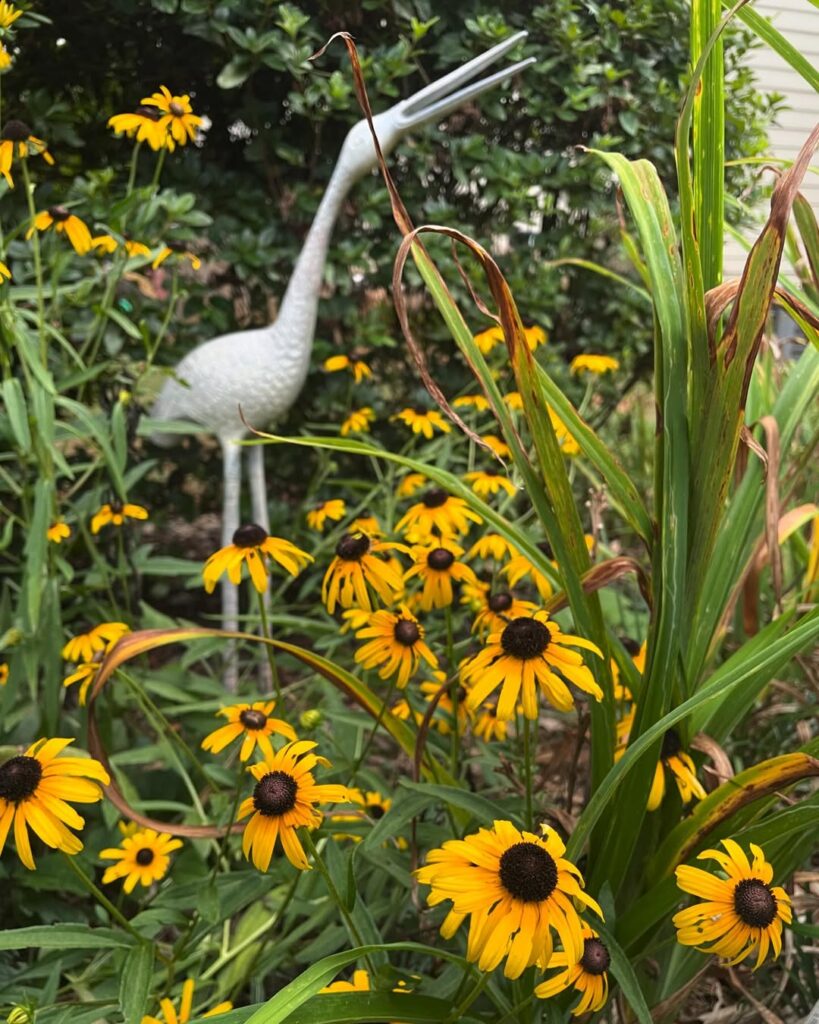
Black-Eyed Susan (Rudbeckia hirta) is Maryland’s beloved state flower, displaying cheerful taxi cab yellow petals surrounding distinctive dark centers. These stunning wildflowers bloom reliably from June through October, reaching 1-3 feet in height. As members of the Daisy Family, they’re found throughout Maryland, with the common variety R. hirta var. pulcherrima dominating most areas while R. hirta var. hirta thrives in Western Maryland’s woodlands.
These resilient perennials excel in natural gardens, meadows, and disturbed areas where they readily self-seed and establish colonies. Black-Eyed Susans provide exceptional wildlife value, attracting diverse pollinators and serving as host plants for Silvery Checkerspot butterflies. Their seeds feed songbirds, particularly goldfinches, while the dried seed cones add winter garden interest. The flowers make excellent cut flowers for indoor arrangements due to their sturdy stems and long-lasting blooms.
- Hardiness: Short-lived perennial, self-seeds readily
- Light: Full sun (6+ hours daily); Western varieties tolerate partial shade
- Water: Drought tolerant once established; minimal water requirements
- Soil: Adaptable to loamy, sandy, or clay soils; well-drained preferred
- Fertilizer: Nitrogen fixer; minimal fertilization needed
- Pest/Disease Resistance: Highly resilient; minimal pest and disease issues
- Growth Rate: Fast establishing; readily colonizes areas through self-seeding
Wild Bergamot (Monarda)

Wild Bergamot (Monarda fistulosa) is a stunning native perennial that brings both beauty and ecological value to Maryland gardens. This member of the mint family produces distinctive ragged pompom flowers in shades of lavender, pink, white, or purple from May through September. Growing 2-5 feet tall with aromatic gray-green foliage, it serves as a pollinator magnet, attracting bees, butterflies, and hummingbird moths throughout its extended blooming period.
Beyond its ornamental appeal, Wild Bergamot offers historical significance as a traditional medicinal herb used for respiratory ailments and mint tea. The brown nutlets that develop after flowering provide additional interest and can be collected for propagation. Its clump-forming habit and non-aggressive spreading nature make it ideal for pollinator gardens, naturalized areas, and borders, while helping to replace invasive species like Dame’s Rocket in Maryland landscapes.
- Hardiness: USDA zones 3-8
- Light: Full sun to partial shade
- Water: Average moisture; drought tolerant once established
- Soil: Average, well-drained soils; adaptable to various soil types
- Fertilizer: Low fertility requirements; avoid over-fertilizing
- Pest/Disease Resistance: Generally resistant; good air circulation prevents powdery mildew
- Growth Rate: Moderate to fast; readily spreading but manageable
Purple Coneflower (Echinacea)
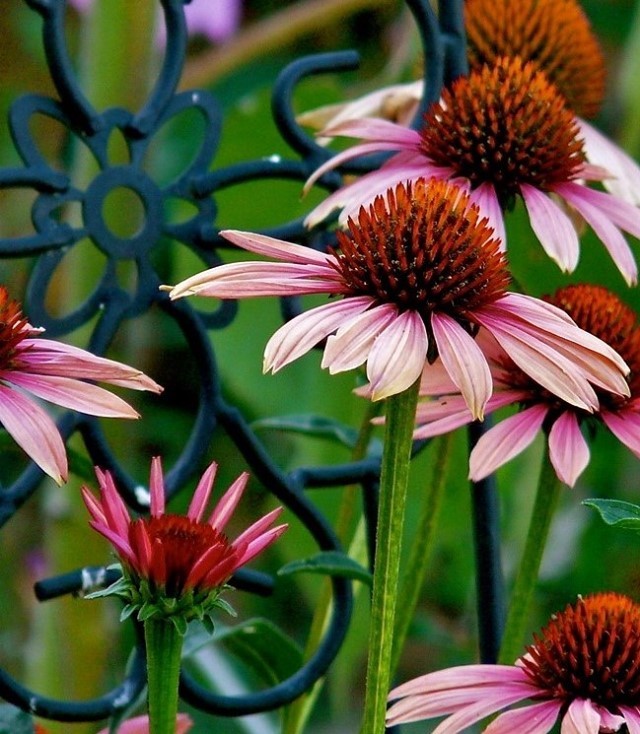
Purple Coneflower (Echinacea purpurea) stands as one of Maryland’s most beloved native wildflowers, offering stunning purplish-pink blooms from June through August. This herbaceous perennial reaches 2-5 feet tall and serves as a pollinator magnet, attracting bees, butterflies, and birds like goldfinches who feast on its seeds.
Beyond its ornamental value, Purple Coneflower provides exceptional ecological benefits as a host plant for Silvery Checkerspot butterfly larvae and various moth species. Its drought tolerance and deer resistance make it ideal for low-maintenance landscapes, while its historical use in traditional medicine adds cultural significance to this versatile native plant. The species thrives in Maryland’s dry open woods, prairies, and barrens throughout its native range in the eastern United States.
- Hardiness: USDA Zones 3-8
- Light: Full sun to partial shade
- Water: Dry to medium moisture; drought tolerant once established
- Soil: Adaptable to clay, rocky, shallow soils; well-draining preferred
- Fertilizer: Low requirements; avoid over-fertilizing
- Pest/Disease Resistance: Generally resistant; deer resistant
- Growth Rate: Moderate; readily naturalizes
Cardinal Flower (Lobelia Cardinalis)

Cardinal Flower (Lobelia cardinalis) is a striking native Maryland wildflower that produces intense velvety red blooms from July through September. Growing 2-4 feet tall, this perennial features terminal flower spikes up to 8 inches long with distinctive two-lipped corollas. The dark green, tapered leaves provide an attractive backdrop to the vibrant scarlet flowers.
This moisture-loving wildflower thrives in Maryland’s wet woods, meadows, and stream banks. Cardinal Flower is exceptional for shade gardens, rain gardens, and pollinator habitats, attracting hummingbirds, butterflies, and large bees. The plant overwinters as an evergreen rosette and naturally expands through offsets, making it an excellent choice for naturalizing in consistently moist areas. Gardeners can easily propagate Cardinal Flower by shaking mature stalks over bare, wet soil to distribute seeds naturally.
- Hardiness: Perennial in Maryland, overwinters as evergreen rosette
- Light: Shade to partial shade preferred; full sun acceptable with consistent moisture
- Water: Consistently moist to wet conditions required
- Soil: Rich, any texture, must remain wet
- Fertilizer: None needed in rich, moist soil conditions
- Pest/Disease Resistance: Deer resistant, generally pest-free
- Growth Rate: Moderate; clumps expand annually through offsets
Wild Columbine (Aquilegia Canadensis)
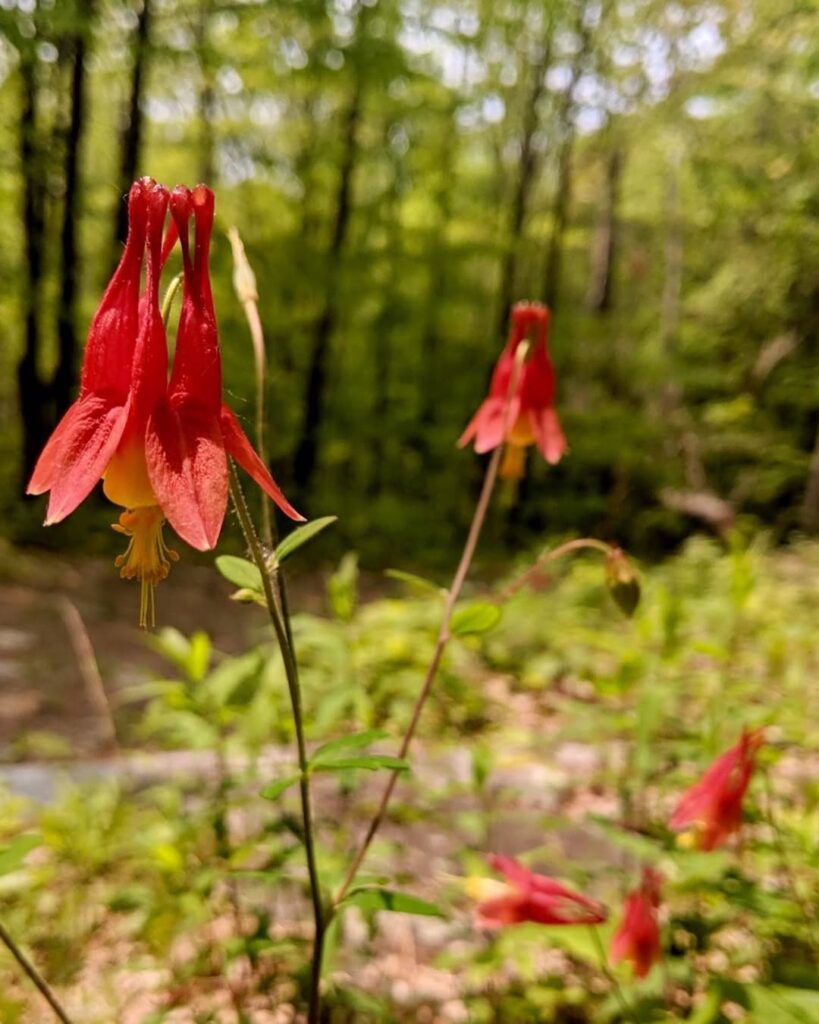
Blooming from April through July with peak flowering in May-June, Wild Columbine thrives in Maryland’s varied landscapes, though it’s less common on the Coastal Plain. This adaptable native self-sows freely in suitable conditions and provides valuable nectar for ruby-throated hummingbirds during their spring migration, while also serving as a host plant for the Columbine Duskywing butterfly. The distinctive red and yellow flowers can reach 2 inches long and emerge on stems that grow up to 3 feet tall.
- Hardiness: Zones 3-8, perennial herb with seasonal dormancy
- Light: Part shade to part sun, moderately shade intolerant
- Water: Adequate moisture required, prefers somewhat moist but well-drained sites
- Soil: Well-drained, pH 6.0 to alkaline, often calcareous soils over limestone bedrock
- Fertilizer: Low maintenance, thrives in natural soil conditions without supplemental feeding
- Pest/Disease Resistance: Deer and rabbit resistant, may develop powdery mildew in summer
- Growth Rate: Vigorous in proper conditions, self-sows freely and spreads naturally
Maryland’s Best Shade Trees
Maryland’s diverse native shade trees offer homeowners excellent options for creating cool, comfortable outdoor spaces while supporting local wildlife through food sources, nesting sites, and year-round shelter. These magnificent trees can reduce electricity bills by up to 25% during summer months by providing natural cooling through their broad canopies.
American Beech (Fagus Grandifolia)
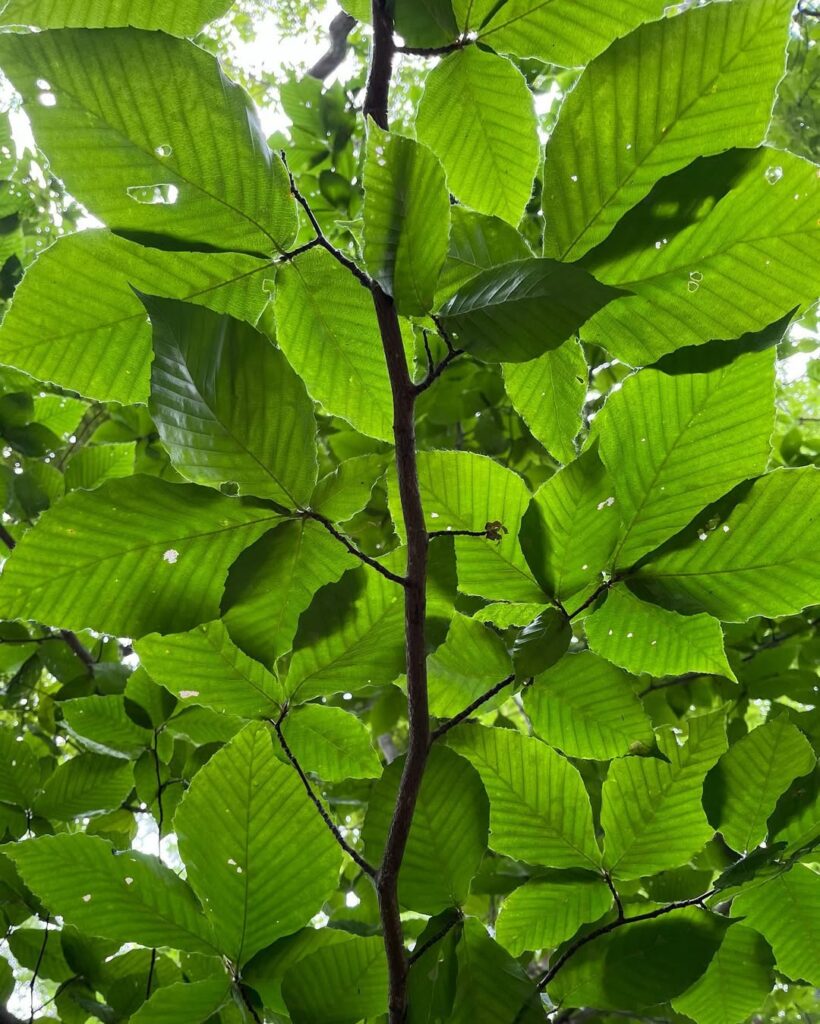
American Beech is a magnificent native shade tree that can reach 50-70 feet in height with an equally wide spread. Its most distinctive feature is the smooth, silver-gray bark that provides year-round visual interest, especially when contrasted with the russet leaves that often persist through winter. This long-lived tree produces glossy dark green foliage that turns golden bronze in fall.
The spiny triangular nuts provide valuable wildlife food, while the tree’s impressive longevity of over 300 years makes it an excellent investment for future generations. American Beech creates dramatic seasonal interest and serves as an outstanding specimen tree for larger landscapes, parks, and forest rehabilitation projects. This shade-tolerant species thrives in the final stage of forest succession, making it ideal for mature woodland gardens.
- Hardiness: Zones 4-9
- Light: Full sun to partial shade
- Water: Medium moisture; intolerant of wet, poorly drained conditions
- Soil: Rich, well-drained soils; tolerates black walnut soils and salt once established
- Fertilizer: Low maintenance once established
- Pest/Disease Resistance: Deer resistant; generally healthy native species
- Growth Rate: Moderate to slow
Tulip Tree (Liriodendron Tulipifera)
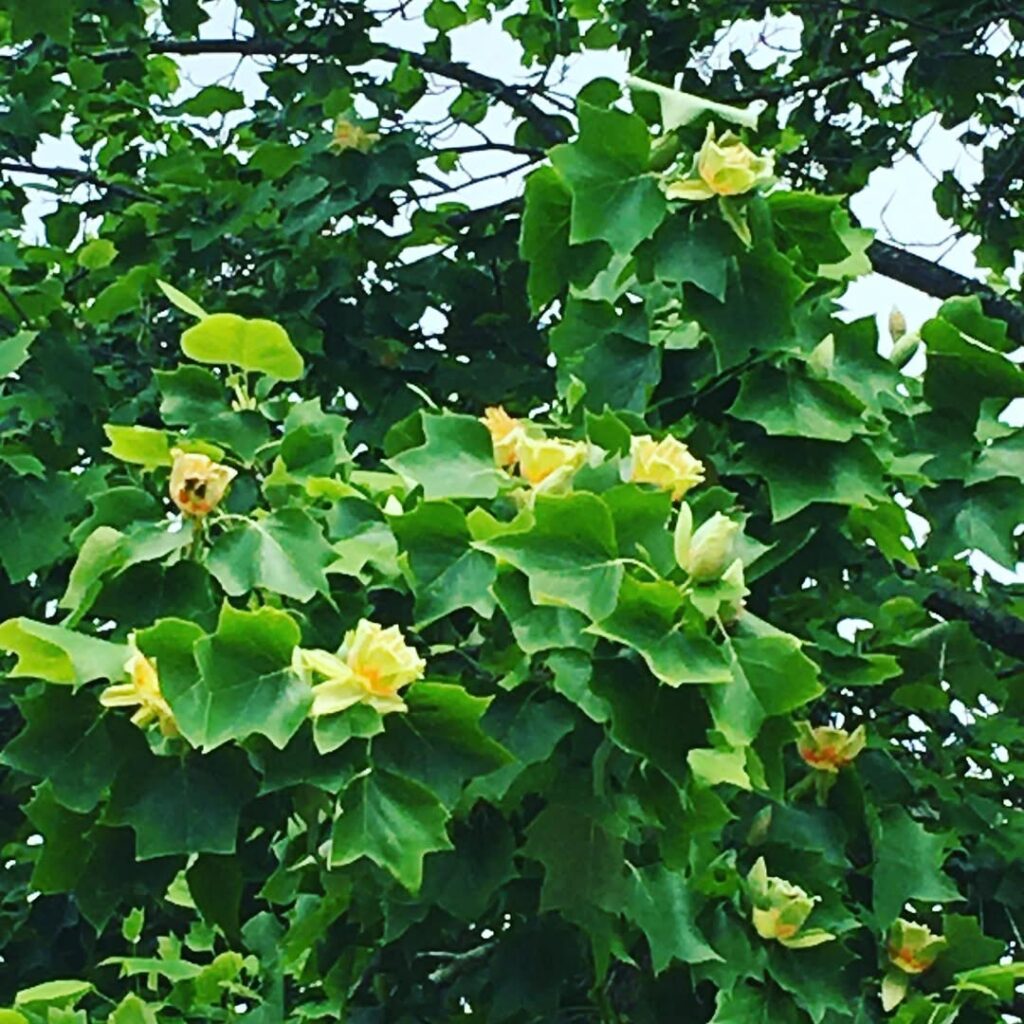
The Tulip Tree stands as one of Maryland’s most impressive native shade trees, reaching towering heights of 100-150 feet with a straight trunk and distinctive star-shaped leaves. Despite its common name “tulip poplar,” this magnificent tree belongs to the magnolia family and produces beautiful yellow-orange tulip-like flowers high in the canopy. Its rapid early growth and long lifespan make it an excellent choice for large landscapes.
This shade-intolerant species thrives as an early successional tree, quickly establishing canopy dominance in forest settings. The Tulip Tree provides exceptional ecological value, supporting pollinators with its nectar-rich flowers and contributing to forest health through its pest and disease resistance. The tree’s fragrant bark becomes deeply furrowed as it matures, adding another distinctive characteristic to this impressive native species. While not suitable for small yards due to its massive size, it serves as an ideal native shade tree for parks, large properties, and restoration projects.
- Hardiness: USDA zones 4-9, well-adapted to Maryland’s climate
- Light: Full sun; shade intolerant
- Water: Consistent moisture; prefers moist but well-drained conditions
- Soil: Well-drained, fertile soils; adaptable to various soil types
- Fertilizer: Generally not required; benefits from organic matter
- Pest/Disease Resistance: High resistance to most pests and diseases
- Growth Rate: Fast; reaches 44-61 feet in 20 years
Red Maple (Acer Rubrum)
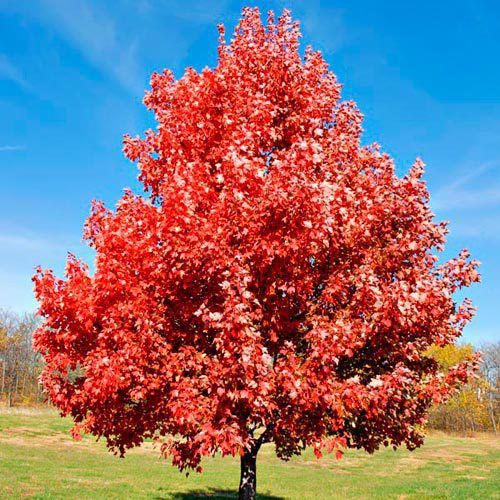
Red Maple (Acer rubrum) stands as one of Maryland’s most versatile and beloved native shade trees, naturally thriving throughout the state’s diverse landscapes from sea level to 3,000 feet elevation. This medium to large deciduous tree reaches impressive heights of 60-90 feet with a distinctive rounded crown, making it an excellent specimen for both residential and urban settings.
The tree’s year-round appeal stems from its vibrant seasonal displays – showy red flower clusters emerge in late winter to early spring, followed by palmate leaves with highly serrated edges, and culminating in brilliant red autumn foliage. Its reddish twigs, buds, and fruits provide distinctive identification features that set it apart from other maple species.
Red Maple reaches sexual maturity remarkably early, sometimes producing flowers and seeds when only four years old, making it one of the first native species to bloom each spring. This rapid reproductive capability contributes to its widespread success across Maryland’s varied ecosystems.
- Hardiness: Zones 3-9, cold hardy and well-suited for Maryland’s climate
- Light: Full sun to part shade, adaptable to various light conditions
- Water: Tolerates both well-drained and wet soil environments; moderately drought tolerant once established
- Soil: Adaptable to various soil types and pH levels; thrives in both upland and lowland conditions
- Fertilizer: Generally requires minimal fertilization; benefits from organic matter incorporation
- Pest/Disease Resistance: Generally resistant to most pests and diseases; occasional issues with scale or leaf spot
- Growth Rate: Moderate to fast growth rate, typically 1-2 feet per year
White Oak (Quercus Alba)
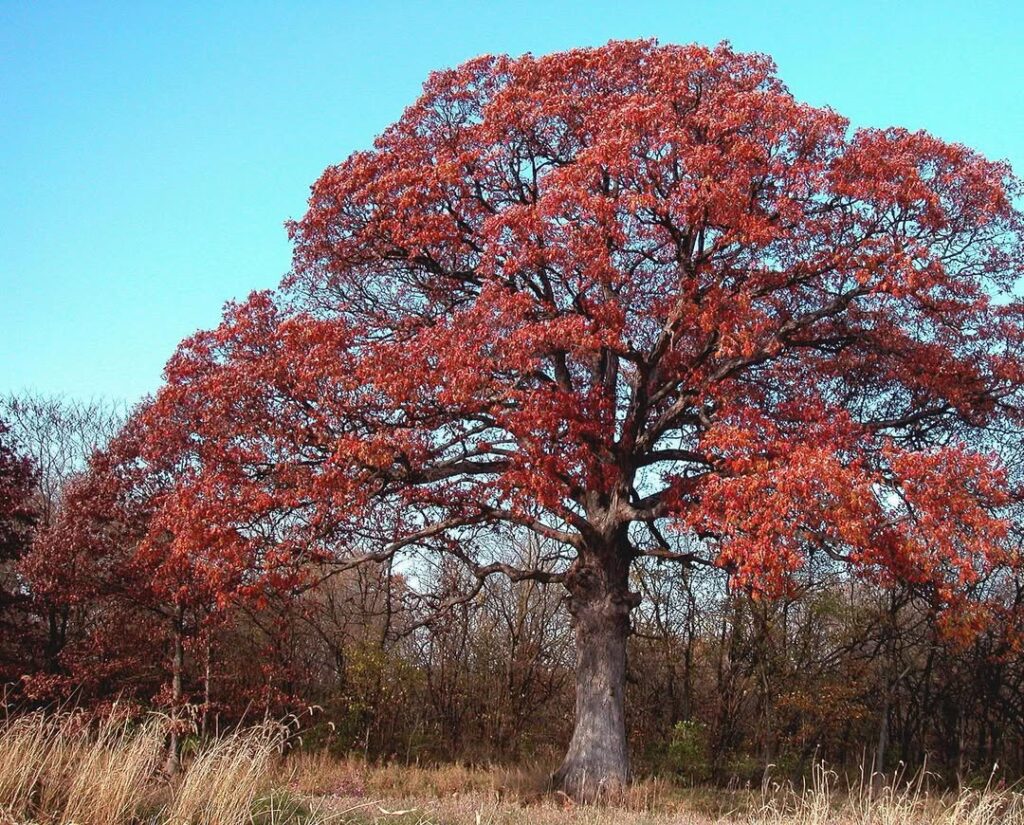
White Oak stands as Maryland’s premier shade tree, reaching magnificent heights of 60-100 feet with an equally impressive canopy spread. This native giant develops a distinctive straight trunk topped by massive horizontal branches when grown in open conditions, creating an iconic silhouette that has graced Maryland landscapes for centuries. The tree’s subtle blue-green summer foliage transforms into striking bronze and wine-red fall colors, while its light gray bark adds year-round visual interest.
As a keystone species supporting local wildlife through acorn production, White Oak provides both ecological value and practical benefits. Its exceptional longevity of 200-300 years makes it a lasting investment, while the dense canopy offers unparalleled shade coverage for large properties and landscapes. The species’ slow growth actually contributes to its superior wood quality, producing strong, tightly grained timber that has been prized for centuries in construction and craftsmanship.
- Hardiness: Zones 3-9, extremely cold hardy and heat tolerant
- Light: Full sun to partial shade; tolerates full shade but grows more slowly
- Water: Moderate; drought tolerant once established, prefers consistent moisture
- Soil: Adaptable to various textures; requires acidic pH below 6.5, avoid very shallow dry soils
- Fertilizer: Generally not required; benefits from organic mulch around root zone
- Pest/Disease Resistance: Generally robust with good natural resistance to most issues
- Growth Rate: Moderate to slow, approximately 1-2 feet per year when young
Eastern Redbud (Cercis Canadensis)

Eastern Redbud is a spectacular native ornamental tree that transforms Maryland landscapes with its vibrant pink to magenta flowers blooming before leaves emerge in early spring. This small understory tree typically reaches 15-30 feet tall with a broad, rounded crown and heart-shaped leaves that provide seasonal interest from reddish spring emergence through golden fall color.
As both an ornamental specimen and ecological asset, Eastern Redbud serves as an early nectar source for native pollinators and supports local wildlife with its seeds. Its compact size and dramatic spring display make it ideal for residential gardens, naturalized groupings, and layered woodland designs where it thrives in partial shade conditions. The tree produces edible flowers that are rich in vitamin C and can be incorporated into salads, breads, and pancakes for culinary use.
- Hardiness: USDA Zones 4-9
- Light: Partial shade preferred; tolerates full sun with adequate moisture
- Water: Moderate moisture needs; not drought tolerant
- Soil: Rich, moist, well-drained soil; prefers alkaline conditions (pH 6.0-8.0)
- Fertilizer: Low requirements; benefits from organic matter
- Pest/Disease Resistance: Susceptible to canker and verticillium wilt; requires good air circulation
- Growth Rate: Moderate
Maryland’s Foundation Shrub Species
Maryland’s foundation shrubs offer exceptional wildlife value, seasonal beauty, and site adaptability. These versatile natives provide structural backbone while supporting pollinators, birds, and beneficial insects year-round. Many species like Black Chokeberry showcase stunning fall color that transforms autumn landscapes into vibrant displays.
Spicebush (Lindera Benzoin)
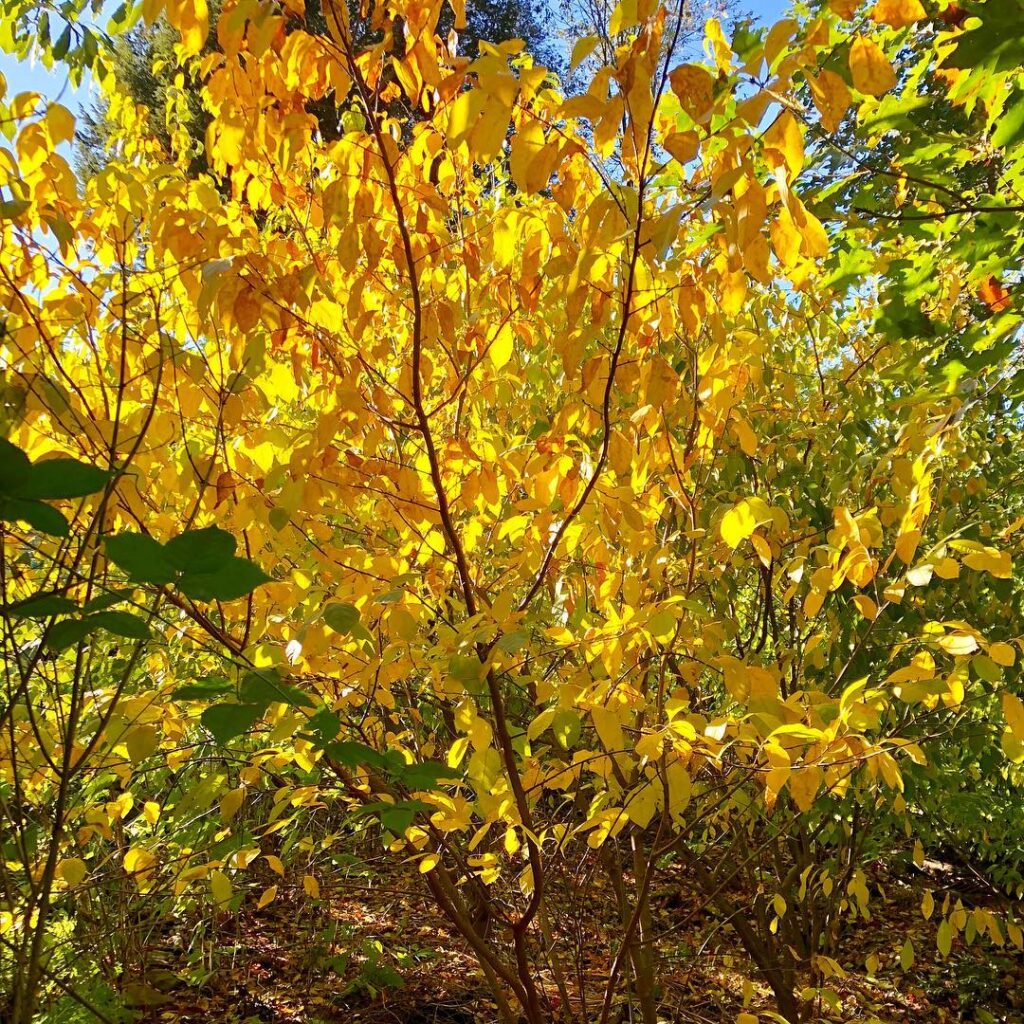
Spicebush (Lindera benzoin) stands as one of Maryland’s most valuable native shrubs, offering exceptional versatility in woodland gardens and shaded landscapes. This graceful deciduous shrub reaches 6-12 feet tall with an attractive rounded form, producing clusters of small yellow flowers in early spring before the leaves emerge. The aromatic foliage releases a distinctive spicy fragrance when crushed, while female plants develop bright red berries in fall.
Beyond its ornamental appeal, spicebush serves critical ecological functions as the primary host plant for spicebush swallowtail butterfly larvae. Its early blooms support native pollinators, and the fall berries provide food for wildlife. The shrub’s adaptability to various moisture conditions makes it suitable for both traditional woodland gardens and rain garden applications. As a dioecious species, spicebush produces male and female flowers on separate plants, requiring both sexes for berry production.
- Hardiness: Zones 4-9
- Light: Part shade to full shade; tolerates full sun with adequate moisture
- Water: Moist to wet soil preferred; drought tolerant once established
- Soil: pH adaptable; tolerates both acidic and alkaline conditions
- Fertilizer: None required; benefits from organic mulch
- Pest/Disease Resistance: Excellent; very few pest or disease issues
- Growth Rate: Moderate to slow
Elderberry (Sambucus Canadensis)
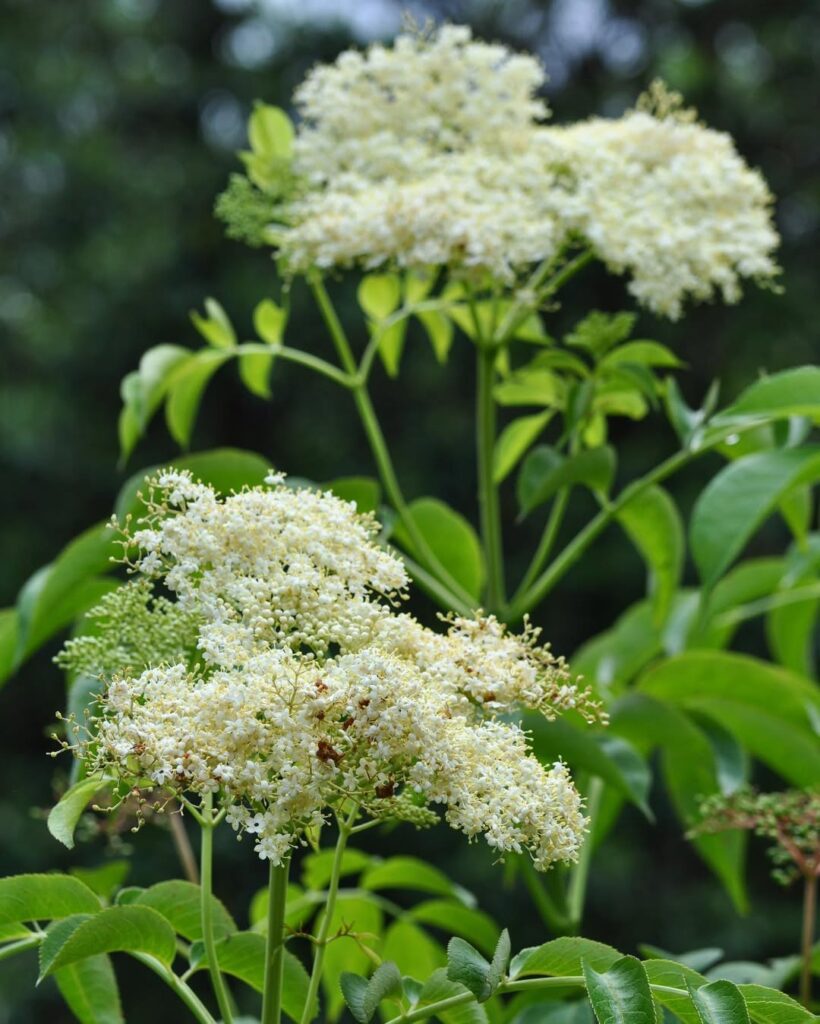
Elderberry (Sambucus canadensis) is Maryland’s quintessential foundation shrub, offering unmatched ecological and practical value. This native deciduous shrub grows 5-12 feet tall with an open, rounded habit and produces spectacular clusters of fragrant white flowers up to 10 inches across from May to July. The flowers attract numerous pollinators before developing into dark purple-black berries that provide critical late-summer food for wildlife.
Beyond its wildlife benefits, elderberry serves human needs through edible berries for jams and wines, plus flowers for teas and beverages. Its adaptability to various light conditions and soil types, combined with tolerance for wet sites, makes it invaluable for rain gardens and restoration projects. The shrub’s dense branching provides excellent wildlife cover while naturally forming thickets for privacy screening. The bark displays a distinctive yellowish-gray coloration with white pith, making identification easier throughout the seasons.
- Hardiness: Native throughout Maryland and eastern United States
- Light: Full sun to partial shade (2+ hours daily)
- Water: Consistent moisture preferred; tolerates occasionally wet conditions
- Soil: Clay, loam, or sand with good organic content; pH 5.5-8.0
- Fertilizer: Low requirements when grown in organically rich soil
- Pest/Disease Resistance: Generally resistant with few serious issues
- Growth Rate: Medium growth rate reaching maturity in 2-3 years
Serviceberry (Amelanchier Canadensis)
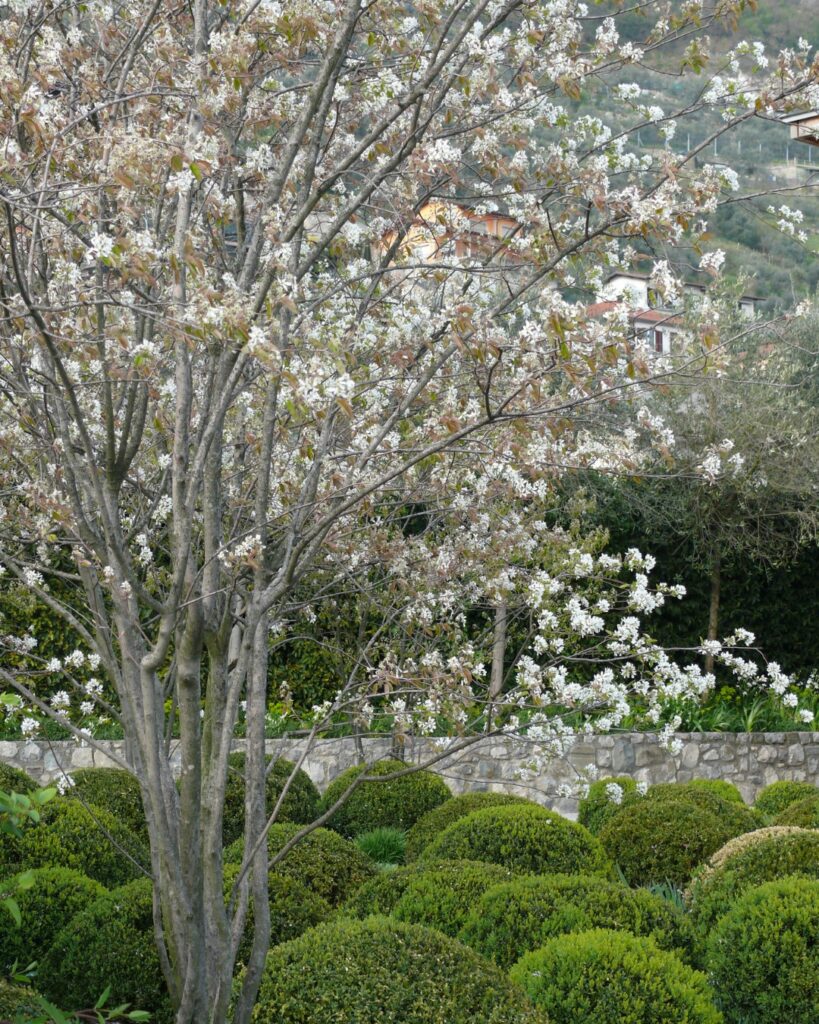
Serviceberry is a versatile native deciduous shrub or small tree in the Rose family that grows 6-20 feet tall with an open, delicate crown. One of spring’s earliest bloomers, it produces stunning white flowers in April-May before leaves emerge, followed by edible crimson to purple fruits that attract birds and wildlife. The plant displays spectacular orange to rusty-red fall foliage and serves as an important host for butterflies and moths while supporting pollinators like honeybees.
This adaptable Maryland native thrives in diverse conditions and functions excellently as an understory tree or clustered planting. Multiple species including downy, Canadian, and Allegheny serviceberry naturally hybridize, creating numerous variations. Its early successional nature makes it valuable for naturalizing disturbed areas, while cultivars like ‘Autumn Brilliance’ work well in designed landscapes combined with understory plantings. The species adds impressive height variation to landscape beds, reaching 25-30 feet tall with a 15-20 foot spread.
- Hardiness: USDA zones 4-9
- Light: Full sun to part shade
- Water: Moderate; tolerates varying moisture levels and moderate drought
- Soil: Adaptable to diverse soil types including coarse loamy sands and sandy loams
- Fertilizer: Low maintenance; benefits from mycorrhizal associations for nutrient acquisition
- Pest/Disease Resistance: Subject to various issues but damage typically cosmetic rather than life-threatening
- Growth Rate: Moderate
Ninebark (Physocarpus Opulifolius)
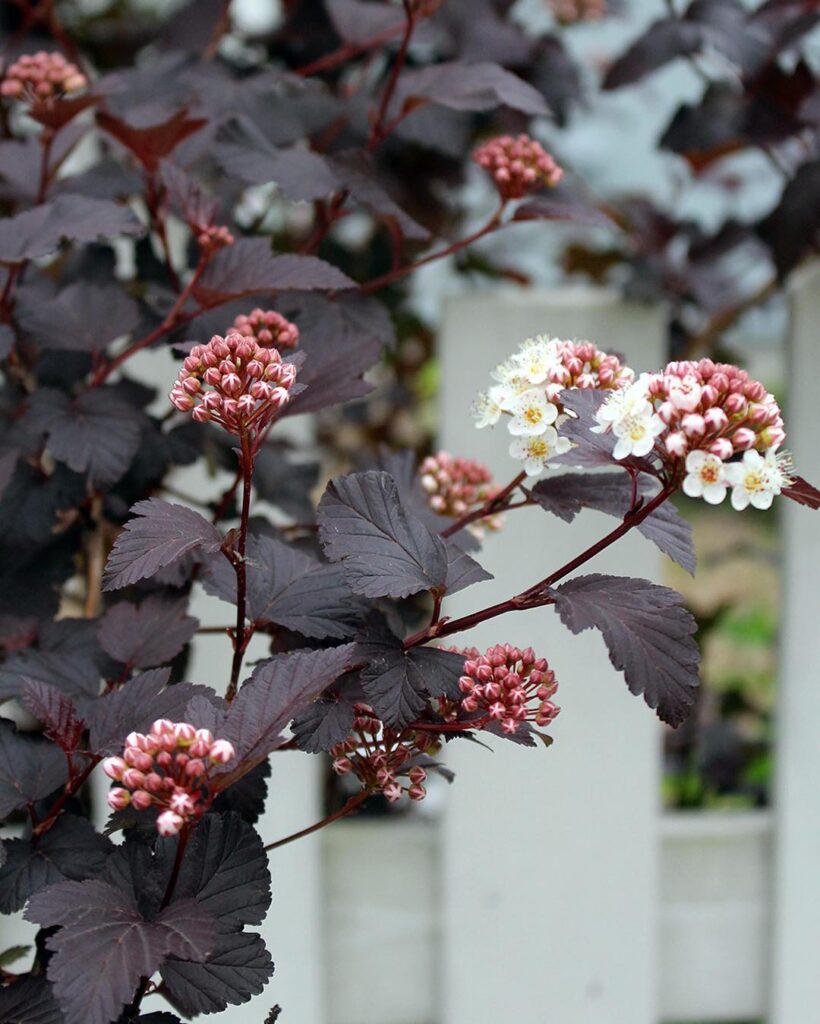
Ninebark is a versatile deciduous shrub reaching 5-10 feet tall with distinctive peeling bark that reveals reddish-brown inner layers. This Maryland native produces clusters of white to pinkish flowers in late spring, followed by persistent red-burgundy fruit capsules. Its mounded shape and arching branches make it ideal for foundations, borders, and naturalized areas.
Beyond its ornamental appeal, ninebark serves as an excellent wildlife plant, providing nectar for native bees and food for birds while hosting multiple moth species. The shrub offers year-round interest with spring blooms, colorful fall foliage, and winter bark texture, making it a superior alternative to invasive species in Maryland landscapes. The plant thrives in its natural habitat on rocky hillsides, streambanks, and moist thickets throughout the region.
- Hardiness: USDA zones 2-8
- Light: Full sun to partial shade; tolerates shade
- Water: Dry to medium moisture; drought tolerant once established
- Soil: Adaptable to clay, loam, sand; prefers well-drained conditions
- Fertilizer: Low maintenance; minimal fertilization needed
- Pest/Disease Resistance: Generally resistant to major pests and diseases
- Growth Rate: Moderate growth rate
Viburnum (Viburnum Prunifolium)
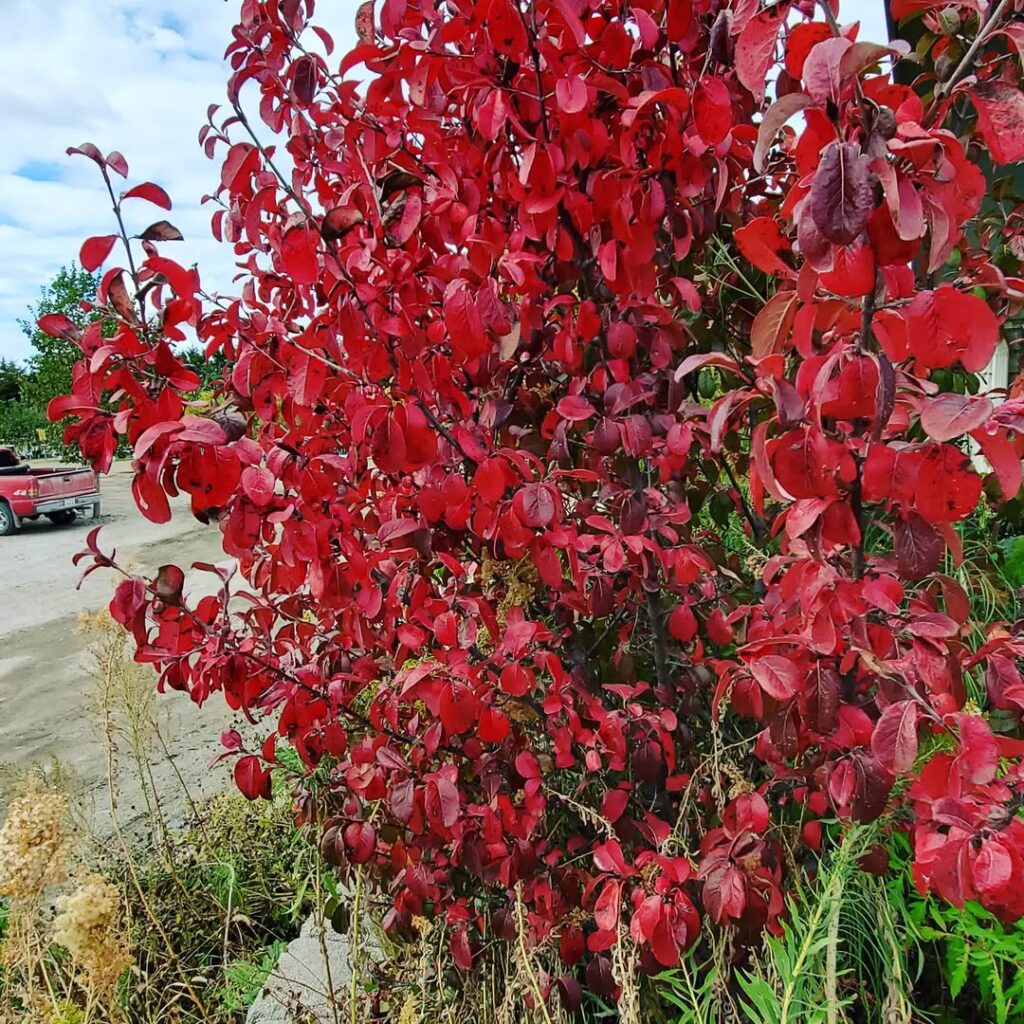
Viburnum prunifolium, commonly known as blackhaw viburnum, is a versatile native shrub that serves as an excellent foundation plant for Maryland gardens. This multi-stemmed deciduous shrub reaches 12-15 feet in height with an equal spread, offering year-round interest through creamy white spring flowers, colorful fall berries, and vibrant autumn foliage.
Beyond its ornamental value, this native viburnum provides exceptional ecological benefits, supporting over 100 species of caterpillars while offering nectar for pollinators and berries for birds and wildlife. The plant also serves as a host plant for various moth species, including the Brown Scallopwing moth. Its adaptability to various growing conditions, combined with low maintenance requirements and moderate deer resistance, makes it an ideal choice for sustainable landscaping in foundation plantings, screens, or naturalized areas.
- Hardiness: USDA Zones 3-9
- Light: Full sun to partial shade (high shade tolerance)
- Water: Dry to medium moisture; drought tolerant once established
- Soil: Adaptable to clay, loam, sand, and shallow rocky soils; tolerates acid, neutral, or alkaline pH
- Fertilizer: Low fertilizer needs; thrives without supplemental feeding
- Pest/Disease Resistance: Good resistance with few significant issues reported
- Growth Rate: Slow growth rate with low maintenance requirements
Selecting the Right Native Plants for Your Garden
How do you choose native plants that’ll actually thrive in your specific garden conditions? Start with these essential planting strategies for successful ecological landscaping:
- Assess your site’s sun exposure, soil moisture, and drainage patterns through seasonal observation
- Get soil testing done by cooperative extension services to understand pH and nutrient levels
- Match plants to existing conditions rather than amending soil extensively
- Research your specific Maryland ecoregion for locally-adapted species
You’ll save time, money, and effort by working with nature instead of against it. Native plants already adapted to local conditions require minimal maintenance once established. These keystone native plants provide exceptional value by supporting entire food webs and wildlife communities in Maryland ecosystems.
Frequently Asked Questions
When Is the Best Time to Plant Native Maryland Species?
Like nature’s perfect timing, fall’s your golden window for planting native Maryland species. Best planting seasons run September through early November, when climate considerations favor cooler temperatures and increased rainfall for ideal establishment.
How Much Do Native Maryland Plants Typically Cost?
You’ll find native plant pricing varies by size—quart containers cost $7-$12, while gallon pots run $11-$17. For cost comparison, plug kits offer better value at $120-$130 for multiple plants.
Where Can I Purchase Native Plants in Maryland?
You’ll discover gardening treasures at local nurseries like Redbud Native Plant Nursery and Herring Run Nursery, plus online retailers such as Lauren’s Garden Service offer convenient shopping with pickup options.
Do Native Maryland Plants Attract Deer to My Garden?
Yes, some native Maryland plants attract deer to your garden through deer behavior patterns favoring species like white turtlehead and turk’s cap lily. Smart garden design using deer-resistant natives like black-eyed Susan reduces this attraction.
How Often Should I Water Newly Planted Native Species?
Like medieval gardeners tending castle grounds, you’ll check soil moisture daily for two weeks after planting. Water deeply when top six inches feel dry, maintaining this watering frequency for ideal establishment.
